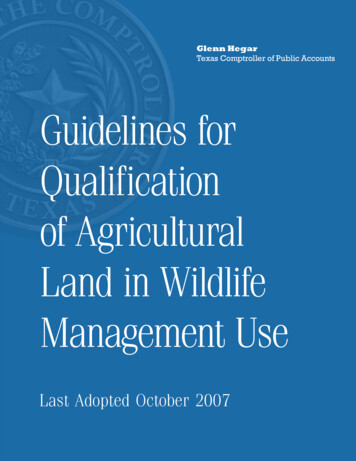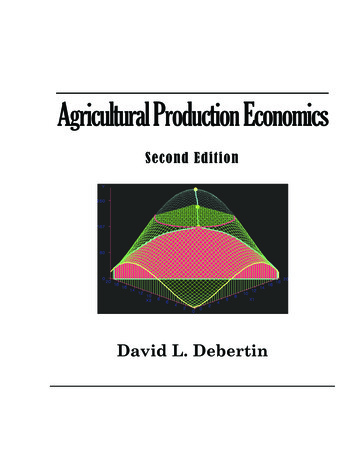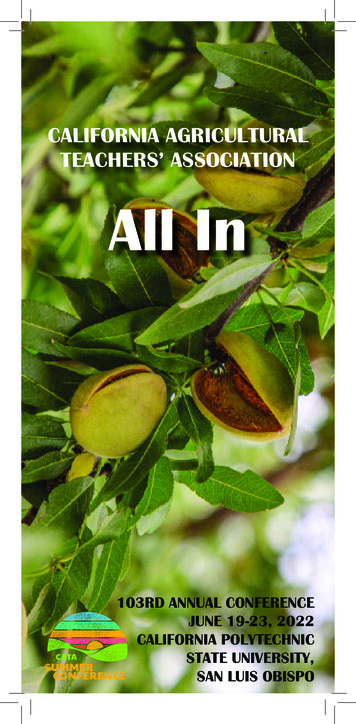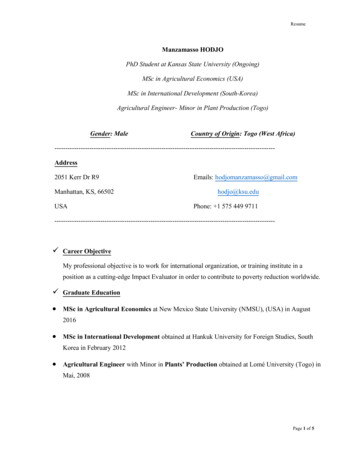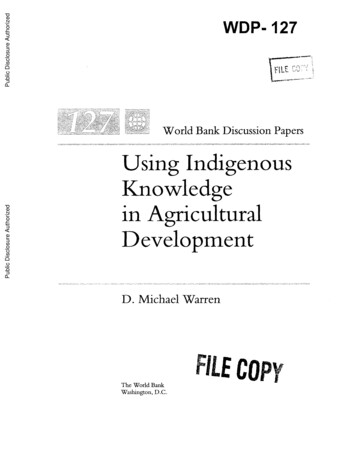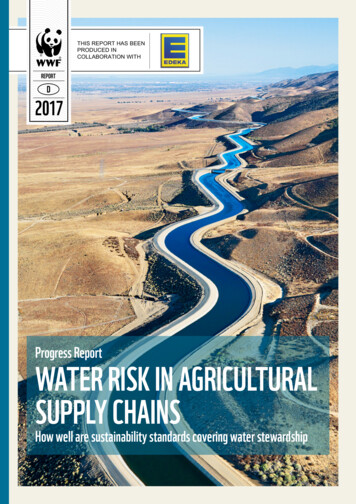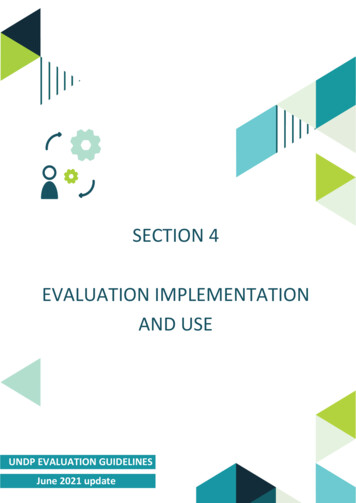
Transcription
EVALUATION OF AGRICULTURALBEST-MANAGEMENT PRACTICES IN THECONESTOGA RIVER HEADWATERS,PENNSYLVANIA:Effects of Pipe-Outlet Terracingon Quantity and Quality ofSurface Runoff and Ground Waterin a Small Carbonate-Rock BasinNear Churchtown, Pennsylvania,1983-89WATER-QUALITY STUDY OF THECONESTOGA RIVER HEADWATERS,PENNSYLVANIABy Patricia L Lietman, Linda C. Gustafson-Minnich, and David W. HailU.S. GEOLOGICAL SURVEYWater-Resources Investigations Report 94-4206Prepared in cooperation with thePENNSYLVANIA DEPARTMENT OF ENVIRONMENTAL PROTECTIONLemoyne, Pennsylvania1997
U.S. DEPARTMENT OF THE INTERIORBRUCE BABBITT, SecretaryU.S. GEOLOGICAL SURVEYGordon P. Eaton, DirectorFor additional informationCopies of this report may bewrite to:purchased from:District ChiefU.S. Geological Survey, WRD840 Market StreetLemoyne, Pennsylvania 17043-1586U.S. Geological SurveyBranch of Information ServicesBox 25286Denver Federal CenterDenver, Colorado 80225-0286
CONTENTSPageAbstract. 1Introduction. 2Purpose and scope. 2Approach. 3Site location and description. 4Selected best-management practices. 4Acknowledgments. 4Methods. 6Sample-collection network and analysis. 6Data analysis. 7Estimations. 8Quality assurance. 10Selected factors that can affect water quantity and quality. 13Topography, physiography, and geology. 13Climate. 13Agricultural activities. 14Soils. 22Effects of pipe-outlet terracing on quantity and quality of surface runoff. 25Quantity. 25Quality. .29Effects of pipe-outlet terracing on quantity and quality of ground water. 46Quantity. 47Quality. 51Summary and conclusions. 60References cited. 61
ILLUSTRATIONSPageFigures1-2. Maps showing:1. Location of the Conestoga River Headwaters project area and Field-Site 1. 32. Field-Site 1 topography and surface-runoff, ground-water, and precipitation-sampling locationsbefore and after terraces were constructed. 53-4. Graphs showing:3.-Total monthly precipitation at Field-Site 1 around normal. 154. Total precipitation at Field-Site 1 during each study period that occurred when the monthlyaverage air temperature was 20 to 80 degrees Fahrenheit. 165.-Cropping patterns at Field-Site 1 for the 1983-89 crop years. 176-9. Graphs showing:6. Monthly nitrogen and phosphorus applications to Field-Site 1. 197. Nitrogen-application rates for each field at Field-Site 1 for crop years 1985-89. 208. Concentrations of atrazine in composite soil samples of the top 2 inches at Field-Site 1. 249. Total storm precipitation, maximum 30-minute intensity within each storm, and storm durationfor all storms, storms producing runoff, and storms that did not produce runoff duringpre-best-management practice Period 1 and post-best-management practice Periods 2,3,and 4 at Field-Site 1 . 26lO.-Hydrographs of runoff at Field-Site 1 for a storm from Periods 1,2, and 3 with similar amounts ofrainfall and similar soil conditions. 2711-31 .-Graphs showing:11.-Total storm runoff as a function of total precipitation at Field-Site 1 for all runoff events exceptrunoff on frozen ground for pre-best-management practice Period 1 and post-best-managementpractice Periods 2,3, and 4. 2812.-Distribution of precipitation data at Field-Site 1 used to group similar type storms into clusters. 3113. Distribution of suspended-sediment and nutrient yields and mean storm concentrationsin runoff from Field-Site 1 for pre-best-management practice Period 1 and post-bestmanagement practice Periods 2,3, and 4. 3414. Total suspended-sediment yield in runoff as a function of total storm runoff for all runoffevents at Field-Site 1 except runoff on frozen ground for pre-best-management practicePeriod 1 and post-best-management practice Periods 2,3, and 4. 3515.-Total nitrate plus nitrite yield in runoff as a function of total storm runoff for all runoff eventsat Field-Site 1 except runoff on frozen ground for pre-best-management practice Period 1and post-best-management practice Periods 2,3, and 4. 3616.-Total ammonia plus organic nitrogen yield in runoff as a function of total storm runoff forall runoff events at Field-Site 1 except runoff on frozen ground for pre-best-managementpractice Period 1 and post-best-management practice Periods 2,3, and 4 . 3717. Total nitrogen yield in runoff as a function of total storm runoff for all runoff events atField-Site 1 except runoff on frozen ground for pre-best-management practice Period 1and post-best-management practice Periods 2,3, and 4. 3818. Total phosphorus yield in runoff as a function of total storm runoff for all runoff events atField-Site 1 except runoff on frozen ground for pre-best-management practice Period 1and post-best-management practice Periods 2,3, and 4. 39
ILLUSTRATIONS-ContinuedPageFigures11-31 . Graphs showing Continued19. Suspended-sediment concentrations in all samples and in samples analyzed for particle size,and percentage of silt and clay in samples analyzed for particle size during the pre-bestmanagement practice Period 1 and part of the post-best-management practice Periods 2and 3 at Field-Site 1.4320. Distribution of instantaneous total phosphorus concentrations in all runoff samples and phaseof phosphorus in a limited number of samples during the pre-best-management practicePeriod 1 and part of the post-best-management practice Periods 2 and 3 at Field-Site 1. 4421. Mean monthly water-weighted total nitrogen and total nitrate plus nitrite concentrations inrunoff from sampled storms and total monthly nitrogen application to Field-Site 1 .4522.-Mean flow-weighted storm concentration of atrazine at Field-Site 1 for the 1983-87 water years.4523. Estimated water-table configuration at Field-Site 1 on November 2,1982, and transmissivitiesof the Zooks Corner Formation. 4624.--A, Precipitation minus potential evapotranspiration. B, Depth to water table from land surfaceat well LN 514,11 miles from Field-Site 1, and at wells LN 1643, LN 1645, LN 1646,LN 1650, and LN 1651 at Field-Site 1 for water years 1983-89. 4825.-Double-mass comparison of cumulative residuals from 1984 and 1989 water years atwells LN 1659 and LN 1643 at Field-Site 1. 5026. Double-mass comparison of cumulative residuals from January 1983 through September 1989at LN 1643 and wells A, LN 1645; B, LN 1646; C, LN 1650; and D, LN 1651, at Field-Site 1. 5027. Concentrations of nitrate (as nitrogen) in recharge and nonrecharge samples at Field-Site 1collected at wells LN 1643, LN 1645, LN 1646, LN 1650, and LN 1651 and concentrationsof all nitrate samples collected at spring LN SP58. 5228. Atrazine and cyanazine concentrations in water from wells LN 1645 and LN 1646 at Field-Site 1. 5429. Alachlor and metolachlor concentrations in water from wells LN 1645 and LN 1646 at Field-Site 1. 5530. Atrazine concentrations in water samples from well LN 1650 before and after atrazine applicationon May 23,1984, at Field-Site 1. 5631.--Concentrations of nitrate at Field-Site 1 in ground-water samples from wells LN 1643, LN 1645,LN 1646, LN 1650, LN 1651, and spring LN SP58 for pre-best-management Period 1 andpost-best-management practice Periods 2,3, and 4. 57
TABLESPageTable1.-Data-collection network during the post-best-management practice period (October 1984-July 1989)at Field-Site 1. . 72. Primary characteristics and chemical constituents for which precipitation, surface-runoff, orground-water samples were analyzed during the post-best-management practice period(October 1984-July 1989).83. Sampling schedule for nutrients and herbicides at Field-Site 1 (January 1983-July 1989).94. Regression statistics for suspended-sediment and total nutrient yields as a function of total runofffor all sampled storms. 115. Summary statistics for quality-assurance analyses (October 1985-July 1989). 126. Precipitation at Field-Site 1 and the 30-year mean at Morgantown, Pa. 147. Characteristics of storms that occurred at Field-Site 1. 168. Crops and acreage at Field-Site 1 for the 1983-89 crop years. 169. Schedule of plowing, planting, and harvesting at Field-Site 1. 1810. Nitrogen and phosphorus applied to Field-Site 1 during the post-best-management practice period(October 1984-July 1989). 2111.-Nutrient applications to Field-Site 1 by crop. 2112. Herbicides applied to Field-Site 1, as reported by farmers. 2213. Summary statistics of nutrient data for soil samples collected at Field-Site 1 from November 1984through June 1989. 2314.-Discharge and percentage of precipitation as runoff from Field-Site 1. 2715.-Regression statistics for the log of total storm runoff at Field-Site 1, in inches, as a function of thelog of storm precipitation, in inches, for all storms in each period. 2816. General storm characteristics at Field-Site 1, by cluster, and percentage of total precipitation byperiod and cluster. 3017. Summary of Mann-Whitney test results comparing, within clusters, total discharges betweenpre- and post-best-management practice periods at Field-Site 1. 3218. Suspended-sediment and nutrient yields in runoff from Field-Site 1. 3319. Regression statistics for suspended-sediment and total nutrient yields as a function of total stormrunoff for all runoff events occurring during each period at Field-Site 1. 4020. Summary of Mann-Whitney test results comparing, within clusters, mean storm sediment andnutrient concentrations in runoff between pre- and post-best-management practice periodsat Field-Site 1. 4121. Summary statistics for all storms and storms producing runoff, within clusters, for totaldischarges and nutrient mean storm concentrations for pre- and post-best-managementpractice periods at Field-Site 1. 4222. Locations and descriptions of ground-water data-collection sites at Field-Site 1. 4723. Percentage of precipitation that recharged ground water, ground-water discharge, and dissolvednitrate yields in ground water from Field-Site 1. 4924. Median nitrate concentrations in ground water at Field-Site 1 and results of Mann-Whitney testingbetween pre- and post-best-management practice periods. 58
CONVERSION FACTORS, VERTICAL DATUM, ANDABBREVIATED WATER-QUALITY UNITSTo obtaininch (in.)inch (in.)foot(ft)mile lometerAreaacresquare mile (mi2)4.0472.590square kilometersquare kilometerDischargecubic foot per second (frVs)gallon per minute per foot (gal/min)/ft0.028320.2070cubic meter per secondliter per second per meterVolumecubic foot (ft3)gallon (gal)0.028323.785cubic meterliterMasspound (Ib)ton (short, 2,000 pounds)pound per ton (Ib/ton)pound per acre (Ib/acre)ton per acre (ton/acre)pound per gallon (Ib/gal)pound per 100 gallons (lb/100 mmetric tonkilogram per metric tonkilogram per hectaremetric ton per hectarekilogram per literkilogram per literTransmissivitysquare foot per0.09290square meter per dayTemperaturedegree Fahrenheit ( F) C 5/9 ( F - 32)degree Celsius ( C)Other AbbreviationsAbbreviated water-quality units used in report:milligrams per liter (mg/L)micrograms per liter (ug/L)micrograms per kilogram (ug/kg)micrometers (um)microsiemens per centimeter at 25 degrees Celsius (uS/cm)Sea level: In this report, "sea level" refers to the Nah'onal Geodetic Verh'cal Datum of 1929 a geodetic datum derived froma general adjustment of the first-order level nets of the United States and Canada, formerly called Sea Level Datum of 1929.VII
EVALUATION OF AGRICULTURALBEST-MANAGEMENT PRACTICES IN THECONESTOGA RIVER HEADWATERS, PENNSYLVANIA:Effects of Pipe-Outlet Terracing on Quantity and Qualityof Surface Runoff and Ground Water in aSmall Carbonate-Rock BasinNear Churchtown, Pennsylvania, 1983-89Patricia L Lietman, Linda C. Gustafson-Minnich, and David W. HallABSTRACTThe effects of terracing on the quantity and quality of surface runoff and ground water were investigated bythe U.S. Geological Survey, in cooperation with the Pennsylvania Department of Environmental Protection,during 1983-89 at a 23.1-acre agricultural site in Lancaster County, Pa., as part of the 1982 Rural Clean WaterProgram. The site, underlain by carbonate rock, was primarily corn and alfalfa fields; the median slope was6 percent. Normal precipitation was about 42 inches per year. Average annual runoff was 11 percent, andground-water recharge was 37 percent of precipitation. Runoff quantity, suspended-sediment and nutrient data,ground-water level and nutrient data, and precipitation-quantity data were collected for 21 months prior to,and 58 months after, construction of pipe-outlet terraces. Data were analyzed by use of graphical, regression,covariate, cluster, Mann-Whitney Rank Sum test, and double-mass curve techniques.Terracing changed runoff characteristics. Storm characteristics were similar throughout the study period.However, after terracing, storms producing less than 0.4 inch of precipitation rarely produced runoff. Total stormdischarge as a function of precipitation did not change significantly throughout the range of runoff-producingstorms after terracing. Multiple discharge peaks on hydrographs before terracing did not occur after terracingwhen hydrographs reflected the stepwise draining of each terrace through the pipe outlet.After an initial 2-year period of terrace stabilization, suspended-sediment yield in runoff decreased significantly as a function of runoff. This result was expected because terracing decreased runoff energy and becauseterrace ponding allowed time for sediment redeposition.Nitrate plus nitrite yields increased proportionally throughout the range of runoff during the post-terracingperiod relative to the pre-terracing period. After terracing, a combination of increased soil contact time andincreased nitrification caused by wetter soils is believed to have increased nitrate concentrations in runoff.No significant change was found in yields of total nitrogen, ammonia plus organic nitrogen, or total phosphorus relative to runoff before and after terracing. Limited data suggest that fine-sediment particles (lessthan 0.62 micrometers in diameter), which continued to be discharged from the site, transported most of thephosphorus.Terracing did not significantly change the quantity of recharge to the carbonate aquifer. The mean annualwater-table altitude did not change after terracing. Nitrate concentrations of ground water increased significantly at four of the site wells after terracing, probably because of increased contact time of the recharge withnutrient-rich soils in ponded terrace water. Qualitative evidence indicates that large decreases in nutrientrequirements and nitrogen applications because of a crop change from corn to alfalfa upgradient of two sitewells resulted in either no detectable change or a significant decrease in nitrate concentrations of ground waterafter terracing.
INTRODUCTIONThe U.S. Geological Survey (USGS), in cooperation with the Pennsylvania Department of EnvironmentalProtection (PaDEP)1, conducted a study to determine the effects of agricultural best-management practices(BMP's) on surface-water and ground-water quality. This study is one of five comprehensive monitoring andevaluation projects in the U.S. Department of Agriculture's (USDA) Rural Clean Waters Program (RCWP).The RCWP, enacted by the U.S. Congress in 1979, designated the Conestoga River Headwaters Basin inPennsylvania as 1 of 20 project areas approved for remedial action to improve stream- and ground-water quality.This area was chosen because it had previously been designated as the top priority watershed in Pennsylvania'sAgricultural 208 Plan. This designation had been made because the project area contains 132 mi of streams thathave considerable existing or potential use for water supply, livestock watering, fish, wildlife, and recreationas well as significant ground-water use for public water supplies. Also, previous studies (U.S. Department ofAgriculture, 1982; Lancaster County Conservation District, 1982; Pennsylvania Department of EnvironmentalResources, 1983) have demonstrated increasing degradation of surface- and ground-water quality caused bylarge nonpoint discharges of suspended sediment and nutrients. The major water-quality problems includenutrients from manure, pesticides from applications to cropland, and sediment from erosion of intensivelycropped land.The objective of the RCWP was to improve surface-water and ground-water quality by voluntary implementation of BMP's, such as construction of terraces, manure storage facilities, and grassy waterways and management of nutrients and pesticides. Funds were allocated to the selected project areas to implement these practiceswith cost-sharing as an incentive and to monitor the effects of implementation on water quality.Water-quality monitoring in the 188-mi2 Conestoga River Headwaters Basin was conducted over a 10-yearperiod (1982-91) at three scales: regional, small watershed, and field. These areas were being monitored beforeand after implementation of BMP's to determine the effects of BMP's on surface-water and ground-water quality.A detailed description of the overall study can be found in "Evaluation of Agricultural Best-ManagementPractices in the Conestoga River Headwaters, Pennsylvania: Methods of Data Collection and Analysis, andDescription of Study Areas" (Chichester, 1988).Field-Site 1, discussed in this report, was located in the Conestoga River Headwaters Basin, betweenChurchtown and Goodville, Lancaster County, Pa. (fig. 1). The site, underlain by carbonate rock, was conventionally tilled cropland, planted primarily in corn and alfalfa. A detailed characterization of Field-Site 1 can be foundin "Evaluation of Agricultural Best-Management Practices in the Conestoga River Headwaters, Pennsylvania:Characterization of Surface-Runoff and Ground-Water Quantity and Quality in a Small Carbonate Basin NearChurchtown, Pennsylvania, Prior to Terracing and Implementation of Nutrient Management" (Lietman andothers, 1996).Purpose and ScopeThis report documents the effects of terracing and nutrient management on surface-water and ground-waterquantity and quality of a 23.1-acre field site, Field-Site 1, in the Conestoga River Headwaters project area. Climatological, agricultural-activity, and soil data as well as surface- and ground-water quantity and quality datacollected after implementation of BMP's (October 1984 through September 1989) are compared to the same typeof data collected at the site before the implementation of BMP's. The pre-BMP period, from January 1983 throughSeptember 1984, is referred to as Period 1. Data from the post-BMP phase of the study is grouped into threetime periods October 1984 through September 1986 is Period 2, October 1986 through September 1988 isPeriod 3, and October 1988 through July 1989 is Period 4. As documented in the following sections, Period 31 Prior to 1995, the Pennsylvania Department of Environmental Protection was the Pennsylvania Department ofEnvironmental Resources.
COMESTOGAHEADWATERSAREAGoodville 1"105x Churchtown.Field-Site 110 KILOMETERSFigure 1 .-Location of the Conestoga River Headwaters project area and Field-Site 1.in the post-BMP phase is the most comparable period to Period 1, the pre-BMP period, in terms of annualprecipitation and nutrient applications to the field. (The 1988 water year2 is comparable to the 1983 wateryear, and the 1987 water year is comparable to the 1984 water year.) In addition, by October 1986, the terraceswere well established (settled), and cropping patterns were stable. Therefore, data from Period 3 and Period 1are compared more frequently throughout this report for discussion of changes because of BMP implementation.The 1989 water-year data were not used as frequently for comparative analysis as the other periods because(1) the cropping pattern for the 1989 water year differed radically from all previous years studied, from65-80 percent corn and 35-20 percent alfalfa in Periods 1 to 3 to 10 percent corn and 90 percent alfalfa in Period 4;(2) regularly scheduled data collection ended in July 1989, so the water year's data is incomplete; and (3) theduration of the 1989 water-year data record is less than half that of the other periods. Because the inclusion ofdata from Period 4 would be misleading in some of the comparative analyses, it is excluded from some of theanalyses in this report. Data from the entire post-BMP period is also sometimes compared to the pre-BMP data.ApproachClimatological conditions are compared to help analyze and normalize the water-quality data for thedifferent periods. Changes in agricultural activities, particularly nutrient-management strategies from thepre-BMP to the post-BMP periods, are discussed. Concentrations of nutrients in the soil are compared toA water year is the 12-month period beginning on October 1 and ending on September 30 and is designated by thecalendar year in which it ends.
determine changes that may affect the water quality. Quantitative and statistical analyses of the water-qualitydata are performed to evaluate the differences among the different study periods and to determine whetherchanges in water quality are attributable to the implementation of the BMP's.All nitrogen or phosphorus species are expressed as their elemental form. For example, whether discussingammonia or nitrate concentrations or loads, all values are expressed as nitrogen. The term ammonia refers to theammonia ion plus free ammonium. The growing season, for the purposes of this report, is defined as the periodMay through October, and the nongrowing season as the period November through April.SITE LOCATION AND DESCRIPTIONThe 23.1-acre site, which is underlain by carbonate rock, is located in the Conestoga River Headwaters,between Churchtown and Goodville, Lancaster County, Pa. (fig. 1). The site, part of two dairy farms, was unirrigated, conventionally tilled cropland and was planted primarily in corn and alfalfa during the study period. Thesilt loam soils are up to 60 in. deep and are moderately to well drained. The
Field-Site 1 except runoff on frozen ground for pre-best-management practice Period 1 and post-best-management practice Periods 2,3, and 4. 38 18. Total phosphorus yield in runoff as a function of total storm runoff for all runoff events at Field-Site 1 except runoff on frozen ground for pre-best-management practice Period 1
